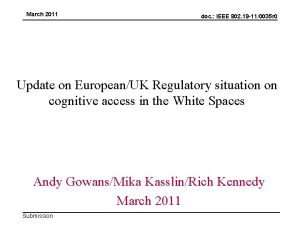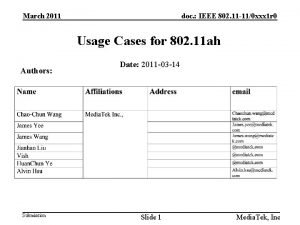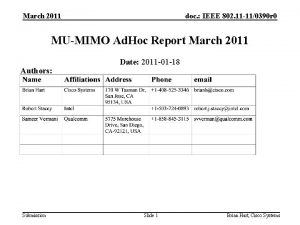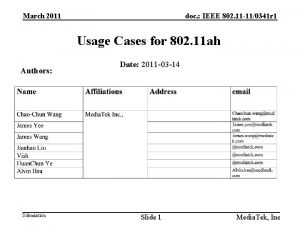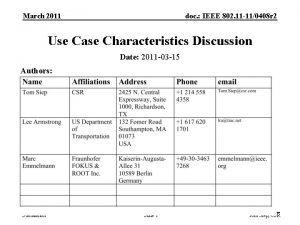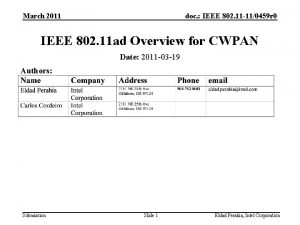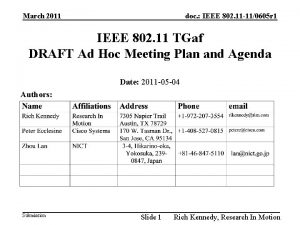March 2011 doc IEEE 802 11 110323 r







![March 2011 doc. : IEEE 802. 11 -11/0323 r 0 References [1] 11 -10 March 2011 doc. : IEEE 802. 11 -11/0323 r 0 References [1] 11 -10](https://slidetodoc.com/presentation_image_h2/5231799c74cc73d306a5188c87af8fe3/image-8.jpg)


- Slides: 10

March 2011 doc. : IEEE 802. 11 -11/0323 r 0 Views on 802. 11 ah Use Cases Authors: Submission Date: 2011 -03 -14 Slide 1 Ron Porat, Broadcom

March 2011 doc. : IEEE 802. 11 -11/0323 r 0 Background • • • 802. 11 ah goal is to standardize a new amendment for unlicensed S 1 G frequencies [1]. However, since those frequencies are unlicensed, there are currently 802. 11 b/g products that are sold in the 900 MHz band (by re-banding) to provide improved outdoor Wi. Fi (for example see [2]). The reason being is that lower frequencies provide improved propagation characteristics. Note that typically S 1 G frequencies have been used for long range outdoor systems such as broadcast terrestrial TV, cellular and military systems. – • • The value of this spectrum is high - recently Verizon Wireless paid ~$10 B for 20 MHz of spectrum in the 700 MHz band to deploy LTE It is unlikely that more unlicensed S 1 G spectrum will be allocated in the future since this spectrum is considered ‘beach front property’ coveted by many entities such as broadcasters and cellular carriers Hence, we should support applications that benefit most from S 1 G frequencies which are given to us for free Submission Slide 2 Ron Porat, Broadcom

March 2011 doc. : IEEE 802. 11 -11/0323 r 0 802. 11 ah Applications • • Currently, a large range of applications are proposed for 802. 11 ah and are summarized in [3]. They can be classified into several categories in several ways. For example: – Indoor and Outdoor extensions of 802. 11 • To be used for any application used today by Wi. Fi users as an added option for extended range (albeit at lower maximum rates) and preferably in conjunction with 802. 11 n and/or 802. 11 ac to allow for efficient usage of S 1 G spectrum when necessary • The required bit rate is only limited by user demand • A typical range may be few tens and up to few hundreds meters in NLOS conditions – Indoor and Outdoor extensions for 802. 11 for M 2 M applications • Rates can be high for Video applications such as surveillance • Rates can be extremely low for other applications such as healthcare, home and industrial automation and control, menu and coupon distribution , transportation control – Can be easily accommodated by using <500 KHz channels • A typical range may be few tens and up to few hundreds meters in NLOS conditions • In general M 2 M rates are somewhat more predictable Submission Slide 3 Ron Porat, Broadcom

March 2011 doc. : IEEE 802. 11 -11/0323 r 0 Cont. – Outdoor smart grid • Rates per client are extremely low (can also be accommodated by using <500 KHz channels) but the required range is highest among the proposed applications. • The number of STA per AP is also highest (several thousands) among other scenarios • To summarize, a mix of very low rate and medium rate applications in LAN and WAN scenarios (all four options) Submission Slide 4 Ron Porat, Broadcom

March 2011 doc. : IEEE 802. 11 -11/0323 r 0 Similarities With TVWS • • S 1 G frequencies under consideration are similar to TVWS frequencies and we can expect the same applications to benefit from both TGah and Tgaf amendments. In particular we refer to [4] for a good description of TVWS use cases and briefly state them below. It is clearly seen that they are quite similar to what has been proposed for TGah – – – – Submission Extended Coverage Wi-Fi Bridge among Small Networks In home media distribution WISP/WAN Cellular Offloading Wi-Fi Direct M 2 M Smart Grid Slide 5 Ron Porat, Broadcom

March 2011 doc. : IEEE 802. 11 -11/0323 r 0 Views • Scenarios - 802. 11 ah benefits range extension scenarios when compared to current 802. 11. As such, use cases 1 a-1 d, 2, 3, 4 a, 5 from [3] are more inline with TGah PAR with the following comments: – – – • Mobility – some outdoor use can benefit from mobility support. The system should be optimized for up to pedestrian speeds. Support for higher speeds is FFS. Medium rates use cases are supported provided they meet the system capability based on its BW and MIMO configuration (number of concurrent HDTV transmissions may be very limited and usage of SDTV instead of HDTV may be preferred). System BW – in order to have a manageable number of modes we propose bandwidths of 2. 5/5/10 MHz. Narrower bandwidths are FFS Dynamic usage of frequencies – many of the scenarios proposed can benefit from the new 900 MHz but can also be deployed at 5 GHz at least to some extent. For example video streaming can use 5 GHz for shorter distance and 900 MHz for far away clients – to the extent possible we support efficient and dynamic usage of all available frequencies. Submission Slide 6 Ron Porat, Broadcom

March 2011 doc. : IEEE 802. 11 -11/0323 r 0 Cont. • Interference between low BW applications and high BW applications - many schemes can be explored i. e. per country channel maps whereby for example in the case of the US the lowest X (e. g. 5) MHz of the available 26 MHz spectrum can be reserved to low BW applications. • Indoor applications - some indoor applications can benefit from the improved propagation at 900 MHz but low bit rate applications (e. g. 1 e-1 h) can definitely also work at higher frequencies as the plot in the Appendix shows and using current 802. 11 b/g/n/ac. Submission Slide 7 Ron Porat, Broadcom
![March 2011 doc IEEE 802 11 110323 r 0 References 1 11 10 March 2011 doc. : IEEE 802. 11 -11/0323 r 0 References [1] 11 -10](https://slidetodoc.com/presentation_image_h2/5231799c74cc73d306a5188c87af8fe3/image-8.jpg)
March 2011 doc. : IEEE 802. 11 -11/0323 r 0 References [1] 11 -10 -0001 -13 -0 wng-900 mhz-par-and-5 c. doc [2] http: //www. caworldwifi. com/900 -Mhz-Wi. Fi. html [3] 11 -11 -0301 -00 -00 ah-categories-of-use-cases-and-straw-polls. pptx [4] TVWS MTG Use Cases Draft v 0. 03_clean. doc Submission Slide 8 Ron Porat, Broadcom

March 2011 doc. : IEEE 802. 11 -11/0323 r 0 Appendix Submission Slide 9 Ron Porat, Broadcom

March 2011 doc. : IEEE 802. 11 -11/0323 r 0 Indoor Link Budget • • The following plot shows the SNR for a low power indoor system at 5. 5 Ghz Assumptions: – 11 n path loss formula • – – Submission 10 m breaking point, 5 db shadowing std Path loss includes one shadowing std NF=5 d. B Transmit power 0 d. Bm Transmission BW – 100 KHz Slide 10 Ron Porat, Broadcom












